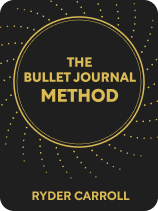

This article is an excerpt from the Shortform book guide to "The Bullet Journal Method" by Ryder Carroll. Shortform has the world's best summaries and analyses of books you should be reading.
Like this article? Sign up for a free trial here .
What is a bullet journal daily log? How do you set up and use a daily log?
A daily log is for capturing any information, thoughts, or ideas that come up throughout the day in the form of tasks, events, and notes. In his book The Bullet Journal Method, Ryder Carroll outlines how to make a daily log.
Here are the steps to follow if you want to make a daily log in your bullet journal.
Making a Daily Log
According to Ryder Carroll, tasks are things that you need to do (such as “schedule doctor appointment”), events are experiences that have either already happened or are scheduled to occur (like “Greg’s birthday June 18”), and notes are facts, ideas, or observations that you want to remember (such as “Amy seemed distracted”).
(Shortform note: Carroll argues that one of the main benefits of the Bullet Journal is that it acts as a standalone organizational tool that eliminates the need for separate mediums like to-do lists, sticky notes, and productivity apps. While for some this strategy may reduce overwhelm, for others, it may only increase it. If keeping everything in one place stresses you out, a tool like a bullet journal daily log—which documents tasks, events, and notes simultaneously—may not be ideal.)
Over time, Carroll says the entries in your daily logs serve as data points that add context to your recollections of the past. For instance, your record of tasks acts as an archive of all you’ve accomplished, and your record of events provides insight into your experiences, especially when your memory fails. You may even notice patterns that can help you be more intentional about your choices (such as noticing that you feel better on the days you order a morning latte from Starbucks).
Similarly, Carroll says that your record of notes can remind you of details that you would have otherwise forgotten, which helps you build stronger awareness in your day-to-day life (like realizing that a friend hasn’t been as supportive as you thought).
| Additional Takeaways From the Daily Log Carroll mentions a few advantages of keeping a bullet journal daily log, but there are additional benefits you can take advantage of. For example, having a record of your accomplishments can be especially useful at work when trying to justify a raise or promotion during a performance evaluation. Moreover, keeping a written record of your days could be a helpful recall tool. Research shows that our memories are often inaccurate due to imperfect perception, the impact of new experiences and emotions on how we view past events, and the inadvertent blending of two separate memories. There is, however, a downside to maintaining a consistent record of your day that Carroll doesn’t touch on: Research suggests that we’re more prone to forget things when we write them down. This means that for your daily log to aid your memory, you might need to review your notes frequently. |
Setting Up and Using Your Daily Log
Carroll says that your first bullet journal daily log should follow your first monthly log. To set it up, turn to the page after the log and number it 11. Then, title the page with the current date. Carroll advises that you shouldn’t add any of your daily logs to your index because they would overwhelm the other entries, and you’ll eventually transfer any actionables or future events from your daily logs to other parts of your journal.
(Shortform note: While Carroll’s reasoning for excluding daily logs from the index makes sense in the case of actionables and future events that are moved to other journal pages, it doesn’t hold true for notes and past events, which remain in the daily log. Because you don’t transfer these entries, they’re difficult to find without the help of an index if you want to look back at them.)
Throughout the day, you’ll write down tasks, events, and notes that are relevant to you, using as much space as you need. You’ll repeat the same process each day, creating new daily logs as part of your nightly or morning review (which we’ll discuss a bit later).
(Shortform note: Having to set aside time to create a new daily log every morning or night could be a disadvantage for those who prefer advanced preparation or have especially busy schedules. If you’re one of these individuals, try preparing a few daily log pages in advance when you have time.)
Rapid Logging
To record information in the most efficient way in your journal, Carroll recommends using a method called “rapid logging.” Rapid logging is a streamlined method of taking notes that focuses on only the most essential information.
For example, in a traditional notebook, an entry might look like this: “My boss said to prepare a presentation on last quarter’s profits for the Sept. 20th meeting.” Using the rapid logging method, it could look like this: “Presentation on Q2 profits for 9/20.” Although rapid logging greatly condenses the task description, it maintains all of the important information: what the presentation is about and when it’s due.
Bullet System
Carroll explains that the practice of rapid logging uses bullets, which lend themselves well to capturing concise and objective thoughts. In the Bullet Journal Method, you use different kinds of bullets to organize information in a way that you can easily understand at a glance.
(Shortform note: While bullet points have long been a preferred note-taking method, their origin is heavily debated. Some say their usage dates as far back as the invention of the first movable-type printing press in the 15th century and that their shape is meant to resemble the munitions of cannons and muskets. While bullets first began as a tool for writing and publishing, their use has expanded to fields like copywriting and computing.)
In Carroll’s system, different bullet types (and in some cases an accompanying set of symbols) correspond to the different categories of information—tasks, events, and notes—that you capture while rapid logging. The purpose of using these symbols is to convey meaningful information in the quickest way possible. Let’s review each category:
Tasks
Carroll says the basic solid bullet (•) corresponds to tasks. Because tasks are meant to be accomplished, this bullet type acts as a sort of checkbox that you can combine with other symbols to communicate the status of each task:
- The solid bullet on its own (•) represents a task that you need to do.
- An (x) represents a task that you’ve completed.
- The greater than symbol (>) represents a task that you’ve transferred to the monthly overview or another project section in your journal.
- The less than symbol (<) represents a task that you’ve transferred to the future planner because it’s not time-sensitive.
- A struck-through task (
task)is one that’s no longer relevant.
Events
Carroll explains that the empty bullet (◦) corresponds to events. Events can be experiences that have already happened or ones that are scheduled to occur at a later date. Although the event category doesn’t use any additional symbols, you can combine it with notes to add details you want to remember about specific events.
Notes
According to Carroll, the dash (-) corresponds to notes. In addition to adding notes to events, you can combine them with tasks to capture further details about a responsibility.
Additional Symbols
In addition, Carroll mentions other symbols you can use to quickly add context to your entries. For example, use the star (*) to mark a priority or the exclamation point (!) to mark an inspiring idea or insight you want to remember.
Carroll says you can also create custom bullets that serve your unique situation. For instance, if you’re in a position of leadership, use a forward slash (/) to mark a delegated task. Or, choose your own symbol to indicate a personally recurring task. (For instance, a teacher might use G to indicate a task related to grading.)

———End of Preview———
Like what you just read? Read the rest of the world's best book summary and analysis of Ryder Carroll's "The Bullet Journal Method" at Shortform .
Here's what you'll find in our full The Bullet Journal Method summary :
- A comprehensive guide to using the Bullet Journal Method
- How to maintain a journaling practice that can improve your overall quality of life
- How to extend the method beyond productivity to a practice in mindfulness






